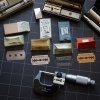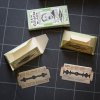I know the old 3 hole blades at the time of the Gillette Old razors were thicker than the blades today.
What about the semi-modern Gillette Blue Blades of the 1930's and he 1940's? Were they also a tad thicker than the current DE blades?
What about the semi-modern Gillette Blue Blades of the 1930's and he 1940's? Were they also a tad thicker than the current DE blades?







